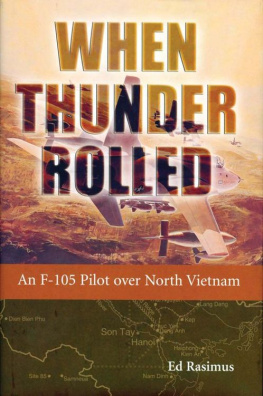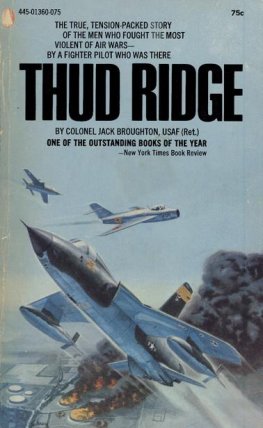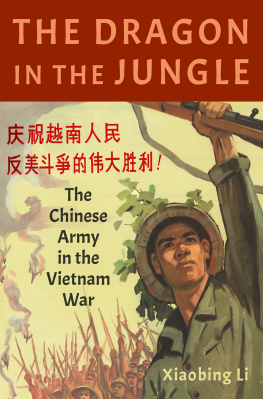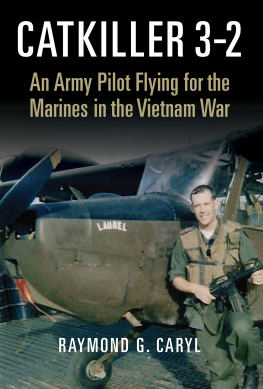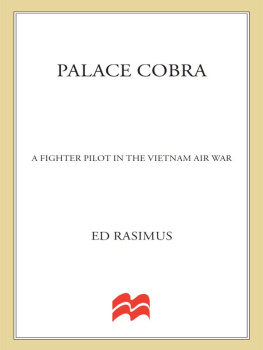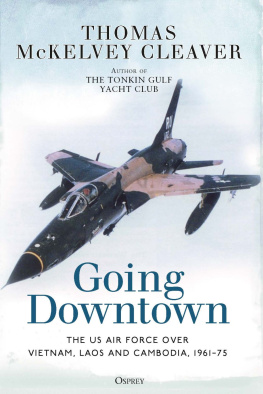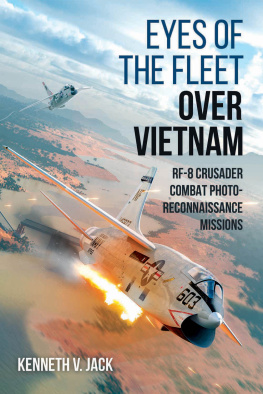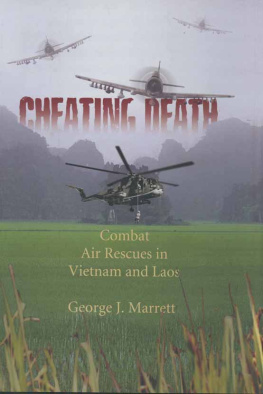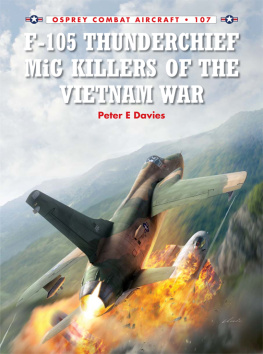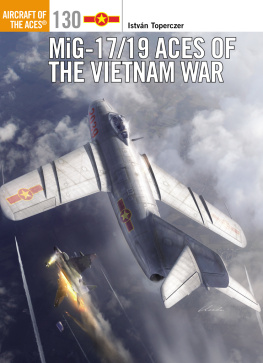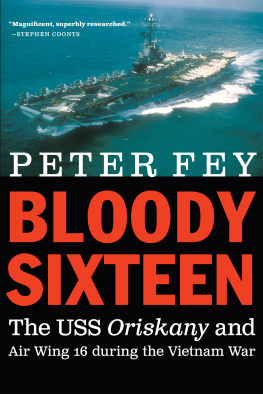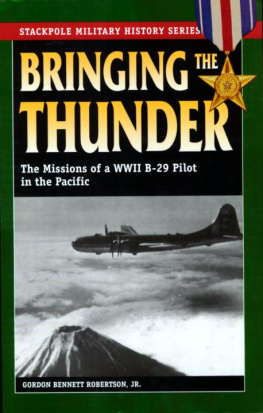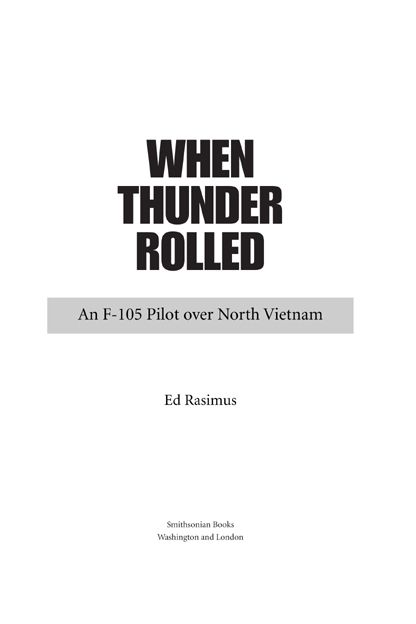2003 by Edward J. Rasimus
All rights reserved
Copy editor: Craig A. Triplett
Production editor: Robert A. Poarch
Designer: Brian Barth
Library of Congress Cataloging-in-Publication Data
Rasimus, Ed.
When thunder rolled : an F-105 pilot over North
Vietnam / Ed Rasimus.
p. cm.
eISBN: 978-1-58834-354-3
1. Vietnamese Conflict, 19611975Aerial operations, American. 2. Vietnamese Conflict, 19611975Personal narratives, American. 3. Rasimus, Ed. I. Title.
DS558.8 .R37 2003
959.704348092dc21
[B] 2002026927
British Library Cataloguing-in-Publication Data is available
This is an electronic release (ISBN 978-1-58834-354-3) of the original cloth edition.
For permission to reproduce the photographs appearing in this book, please correspond directly with the owners of the works, as listed in the individual captions.
Smithsonian Books does not retain reproduction rights for these photographs or illustrations individually, or maintain a file of addresses for photo sources.
v3.1_r2
In memory of Vince Gianinetti,
cowboy, lawman, and fighter pilot without wings.
If you arent living on the edge, youre taking up too much room.
Contents
Acknowledgments
I owe a lot to John Sherwood, official historian of the U.S. Navy and author of Fast Movers: Jet Pilots and the Vietnam Experience, for encouraging me to tell my stories. John made me realize the value of oral history in capturing the visceral and personal emotions of a war. History too often becomes a dry retelling of dates and statistics without the flavor of the participants perspectives. While facts are certainly important, they lack the very important component of personality. John read the first few pages that I had haltingly assembled over several years and pushed me to get serious about the project.
Marshall Michel got me moving faster when we spent some time swapping recollections about Linebacker II at an annual Red River Valley Fighter Pilots reunion. Marshalls Clashes remains the definitive work on MiG engagements of the Vietnam war, and his more recent Eleven Days of Christmas casts new light on the Linebacker II campaign. When he convinced me that there was interest in this type of book, I finally gained confidence that it might get published.
Of course there must be recognition of the loyal wife who supported the effort. Carol, who doesnt really know which end of the airplane the hot air comes out of, took a lot of prodding before she was willing to sit down and read my draft. After years of sitting through war stories and watching a bunch of middle-aged men talking with their hands and shooting their watches, she had little interest. When she finally picked it up and pronounced it readable, I knew there was hope. As the nonaviator in the loop, she was instrumental in showing me where it didnt make sense to the average reader and where it needed more elaboration. Her insights were invaluable.
Thanks should also go to the folks who agreed to read my manuscript and offer objective criticism. Among them are Bill Stroud, F-4 WSO extraordinaire; Bob Hipps, Wolf FAC; GI Basel, Thud driver; Tom Coady, D and G Weasel pilot; Ed Cathcart, Marine F-8/F-4/A-6 pilot; Art Kramer, B-26 bombardier; and Joe Myers, ANG C-130 puke. And a special thanks to Tootie Fouratt, friend, teacher, encourager of aspiring writers, and supplier of the worlds best chicken-fried steak.
For help in digging out historical details, Dennis Jenkins and his great F-105 book, F-105 Thunderchief: Workhorse of the Vietnam War, Jeff Koln, 421st TFS history guru; Howard Plunkett and John Revak, hoarders of details about 105 bailouts; Guy Alcala, Internet military aviation fanatic; Theo Van Geffen, Thunderchief aficionado; and Larry Davis, Wild Weasel history author.
Good stories only become good books with the help of great people. Ive been fortunate to know a lot of them.
Introduction
I moved the throttle outboard and waited patiently for the afterburner to light. When the reassuring push came to the small of my back, I eased back on the stick and started a four-G pull to bring the nose up to thirty degrees. We were doing six hundred knots already, but airspeed would bleed off quickly in the pop-up, and I wanted to have better than four hundred left as I got to the top. The target was a complex of buildings off to my left and the bombs from lead were already offering an aimpoint. The pacing was almost automatic; I didnt need a stopwatch, and I didnt need to look at the altimeter tape winding up. It would take about ten seconds to reach the pull-down altitude and then another six to make the three-dimensional turn from thirty degrees nose up to a 45 degrees dive. Then another six seconds or so to track the target, offset for the wind, and hopefully get the bombs off without getting hit. Make it thirty seconds from pop to pickle to descent back into the weeds. My internal clock was running smoothly.
Lazy red tracks of tracers arched gracefully up from the area just to the east of the target, apparently not shooting at anyone in particular. A few black puffs of 85s detonated well above the attack, again not seeming very coordinated. The radar warning receiver continued its howling, and the center of the vector scope was an angry spider indicating a mass of electronic confusion about how many radars were looking at us, but there were no SAMs airborne yet.
When I checked the altimeter, it was passing ninety-five hundred feet. I rolled and pulled down, watching the altitude continue to increase until the tape reversed direction at just over twelve-thousand feet. I kept pulling, wings-level inverted until the glowing red circle of the sight reticle rested below the dark brown roof of the largest building. Easing the back pressure off, I rolled around the point of the pipper and checked the dive angle. I was just a bit under forty-five degrees, so I would need to press a few hundred feet lower before releasing. Out of the corner of my eye I saw flashes and another airplane tracking level across the horizon. Theres four thousand feet, pickle, pull, roll, jink, come back the other way. Find my flight.
Sweat rolled down from under my helmet and occasionally dripped a salty fog into my eyes that I simply blinked away. Thirty seconds, or possibly the remainder of a lifetime. It didnt much matter. I was on the target and now off and sprinting to regain a position on my leader. I was alive again. Another hash mark on the trek to one hundred missions.
How I got to where I could do the job is the story here. No one could have anticipated the losses that the F-105 forces would suffer during the Rolling Thunder bombing campaign against North Vietnam. We couldnt know then where we fit into the big picture. We simply went because when we signed on we had held up our hands and agreed to defend the Constitution against all enemies foreign or domestic. It turned out that there was a direct correlation between flying the most sorties and taking the most losses, and the Republic F-105 Thunderchief was the weapon of choice for the Rolling Thunder campaign. It was our job, so we did it.
Flying fighters had been my life goal; Id done the necessary things and had made the grade. I had become a fighter pilot and looked forward to a long career of flying exciting airplanes, associating with fun people and living a great life. Then the Vietnam War flared, and flying fighters suddenly got a lot more involved. This is the story of my experiences during six months in 1966 flying the F-105 from Korat Air Base Thailand as a member of the 421st Tactical Fighter Squadron. It is the transition from fear to effectiveness as I faced the challenges of a continually changing war. Its also a thank you to the people who taught me the business and led me through a challenging time in my life.

